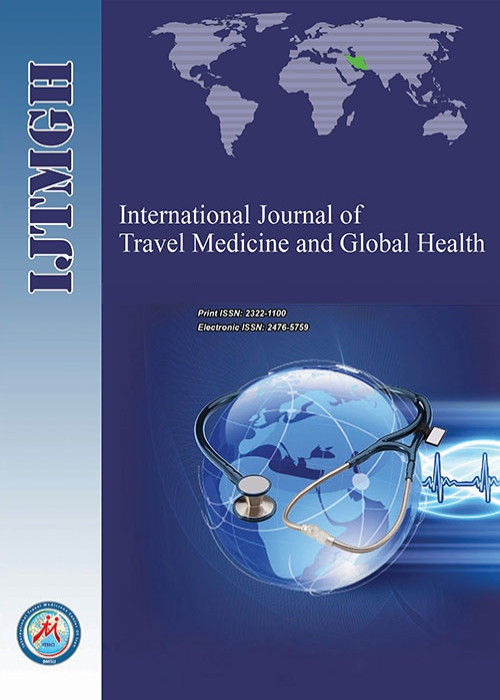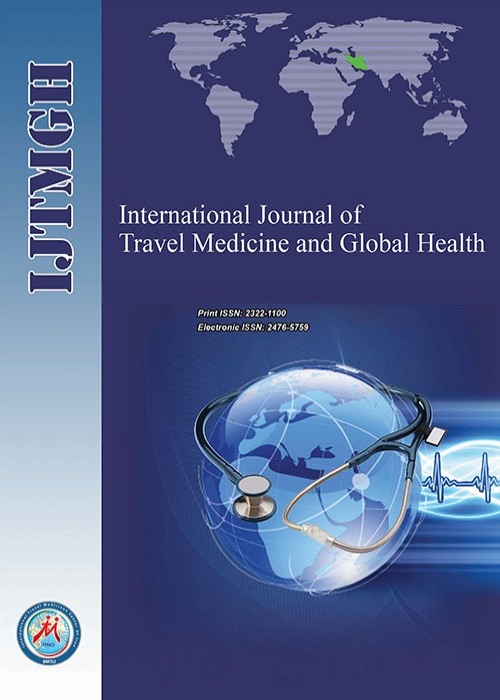فهرست مطالب

International Journal of Travel Medicine and Global Health
Volume:11 Issue: 4, Autumn 2023
- تاریخ انتشار: 1402/09/10
- تعداد عناوین: 8
-
-
Pages 391-401BackgroundC-section prevalence has increased drastically over the past few decades across the globe. This growth has been caused by an array of factors, including maternal, socio-demographic, and institutional factors, and it is a global concern in both developed and developing countries. Therefore, the objective of this study is to identify relevant risk factors for the delivery type, and find a more accurate ML-based model for identifying cesarean women.MethodsThe number of C-sections performed in the nation has increased to at least 45 percent in the two years prior to 2022. Because of this, we have used multiple logistic regression and machine learning algorithms to determine cesarean delivery and identify the socio-demographic risk factor among mothers in Bangladesh.ResultsBivariate analysis results revealed that higher educated mothers and fathers, the richest family, overweight mothers, and hospital delivery had a higher percentage of cesarean babies. With an accuracy of 83.74%, NB (naive Bayes) outperforms the other five classifiers. We can get more precise information than accuracy from the ROC curve and the AUC. Depending on the AUC value, we can see that among all classifiers, Logistic Regression (LR) and Random Forest (RF) provide the most accurate classification for determining c-section.ConclusionsOur findings contribute to a better understanding of how to categorize C-section intentions among Bangladeshi women. The technique will be useful in identifying the women who are most likely to undergo a C-section in the healthcare system. As a result, the government can launch an effective public awareness campaign.Keywords: Cesarean Delivery, Machine Learning (ML) Algorithm, Performance indicator, Bangladesh
-
Pages 402-405The field of immune based therapeutics for treatment of common chronic illnesses has exploded leading to significant improvement in the disease processes but a downstream impact on infections. Janus kinase (JAK) inhibitors and Bruton Tyrosine kinase (BTK) inhibitors are becoming more widely used in treatment of chronic inflammatory diseases and chronic leukemias because of simplicity of oral administration. As such, many patients will have improvement in their underlying illnesses and will have greater flexibility to travel. Thus, it is important for travel medicine practitioners to be aware of these agents, their adverse effects and impact on drug interactions and immunizations.Keywords: Newer biological therapies, Trip planning, Vaccinations
-
Pages 406-411Pandemics, such as the emergence of COVID-19, have their roots in the intricate interplay across animals, humans and the environment. The transition from epidemics to full-blown pandemics can be visualized as the proliferation and spread of transmissions across a web of interlinked networks. These networks encompass not only human-human interactions but also encompass animals, inanimate objects, and elements within the environment. Human civilization has seen an unprecedented increase in the mobilities of humans, animals and artefacts, and formation of innumerable interconnections across them as well as with the environment. Furthermore, there is widespread expansions of these networks, and a global reach. These are in a state of constant flux due to increasing mobilities of their individual nodes as well as their corresponding networks. The interactions occur across predefined pathways (eg. along transport routes) or more randomly (eg. floating atmospheric pollutants). The concept of "Dynamic Physical Hyperconnectivity" is proposed to capture the situation when there is synchronisation or approximation of these high-mobility networks, creating the environment for very close physical connectivities of nodes across adjacent networks. If multiple networks coincide, the connectivities can occur across the globe. This hypothesis could explain the swift worldwide spread of COVID-19 virus during the pandemic, and is supported by preliminary data. If this is proven with modelling, it implies that mitigation of pandemics such as COVID-19 requires a multifaceted approach that curtails the velocity of agent mobility, minimise interaction frequencies, reduces node mobility scope, and disentangles interwoven networks.Keywords: Dynamic Physical Hyperconnectivity, Mobility, Pandemics, COVID-19
-
Pages 412-420Background
Sexual desires and sexual activities are one of the natural needs of human being, which if not used in the right direction, may become problematic and lead to various sexual disorders, including hypersexuality. The aim of this research was to compare the dialectic behavior therapy and aripiprazole drug on impulsive behavior in hypersexual patients.
MethodsThis experimental study based on control and treatment groups with pre-test and post-test and follow up was done on 54 male and female with hypersexuality that were selected and placed randomly in two groups of treatment (18 patients in every group) and one group of control (18 patients). Pre-test stage was done for three groups by Barratt Impulsiveness Scale Version 11 (BIS-11). The first treatment group underwent DBT intervention for 8 sessions of 2 hours (once a week) and the second experimental group was prescribed aripiprazole for two months. The post-test and follow up was done for all three groups. The data were analyzed using SPSS software version 24 and multivariate analysis of covariance (MANCOVA).
ResultsDBT had an effect on the impulsive behavior and improved it (P˂0.01); Aripiprazole had an effect on the motor impulsivity component of impulsive behavior and improved it (P˂0.01). There was a difference between the effects of DBT and aripiprazole, with the greater effect of DBT, in the variables of impulsive behavior (P˂0.01).
ConclusionsBased on the results, it can be said that the intervention of DBT and aripiprazole drug can have an effect on impulsive behavior of patients.
Keywords: Dialectical behavior therapy, Aripiprazole, Impulsive behavior, Hypersexual -
Pages 421-422
Medication tourism carries inherent risks, since there is often no guarantee that the medications purchased overseas are safe or efficacious. Additionally, the medication tourist may encounter legal difficulties associated with importing certain medications into their home country. A World Health Organization report found that up to half of the global drug market consists of counterfeit medication, with a high proportion of these drugs being sold throughout the developing world. As a result of prohibitive costs and low domestic availability of medicines, patients in developing countries have an increased likelihood of purchasing these cheaper alternatives. Travellers with chronic medical illnesses may be unaware of the risks associated with medication tourism. As part of the pre-travel consultation, they should be discouraged from engaging in medication tourism where possible. Otherwise, they should be advised to only purchase their medications from a reputable pharmacy abroad, to present a copy of their prescription to a registered local pharmacist, to check for any legal restrictions on transporting given quantities of certain medications for personal use across international borders, to keep medications in their original, labelled containers, and to store them according to the manufacturer’s instructions.
Keywords: Medical tourism, medication tourism, pharmacy tourism, Travel Medicine -
Pages 423-429IntroductionThis study aimed to assess the effect of low tidal volume ventilation in on-pump Coronary artery bypass graft surgery on pulmonary complications.MethodsThis study was conducted in Baqiyatallah Hospital from June 2021 to June 2022. 60 patients ASA class 1 and 2 CABG candidates were randomly divided into two intervention and control groups. Patients in the intervention group receive ventilation with a tidal volume (3-4 ml/kg) and several 6-8 breaths/minute. The control group doesn't receive any ventilation per the hospital routine after undergoing CPB. Renal and hepatic parameters are recorded before and on the first, second, and third days after surgery. Vital signs, duration of mechanical ventilation in ICU-OH, and duration of hospitalization in ICU were recorded.ResultsThe average Cr, three days after the operation in the first group, was higher than the second group (P=0.037). The average SGPT, three days after the operation in the first group was higher than the second group (P=0.031). The average SGOT after surgery in the first group was higher than in the second group. The average ALK, two days and three days after surgery in the first group was higher than in the second group. The average CRP, three days after the operation in the first group was lower than the second group (P=0.001). ConclusionThis research showed no significant difference in the two groups’ average operation duration, ultrafiltration volume, X Clamp duration, ICU hospitalization duration, mechanical ventilation duration, and CPB duration. Management of ventilation during cardiovascular surgery is challenging.Keywords: Ventilation, on-pump Coronary artery bypass graft surgery, pulmonary complications
-
Pages 430-434
This article emphasizes the importance of preventing common travel-related issues through common-sense measures, often overlooked by travelers. It provides recommendations backed by scientific evidence for travel health advisors to pass on to travelers. Additionally, it highlights the significance of addressing the health concerns of individuals with compromised immunity, such as those with severe immunosuppression. Furthermore, it underscores the need to consider the unique health challenges faced by elderly travelers when journeying to developing countries. The purpose of this study is to provide guidelines for an evidence-based approach to pre-travel counseling and medical considerations for the elderly in a travel clinic.
Keywords: travel disease, Cardiovascular, pulmonary, Malignancy, Thromboembolic, Motion Sickness, Altitude Sickness -
Pages 435-436
As everybody knows, nowadays Israel's attacks Gaza Strip are escalating. According to local and international sources Israel's airstrikes and fighting targets, the residential areas, refugee camps hospitals, ambulances, and schools are still being bombarded. More than 47% of dead are children (1).More than 4,000 children have been killed and thousands were injured, while thousands are still buried under the ruins (2). Almamadani Hospital is one of the tens of hospitals that were totally destructed by the heaviest bombs in the world, causing more than 500 deaths and hundreds being injuries. (3).United Nations officials press released that “More than 400 children reportedly either killed or injured daily” (4) The United Nations has declared the region to be in catastrophe. Due to the lack of medical and health facilities, and the lack of water, electricity, and fuel, unfortunately, the Israeli invading forces, contrary to all international treaties, prevented the arrival of any humanitarian aid such as food, medicine, and medical equipment.Secretary-general of the United Nations, Antonio Guterres, said “Gaza is becoming a graveyard for children. Hundreds of girls and boys are reportedly being killed or injured every day,” highlighted how “the unfolding catastrophe in Gaza makes the need for a humanitarian ceasefire more urgent with every passing hour,” stressing that the protection of civilians is paramount (5).
Keywords: Gaza, children, Refugee, United Nations


